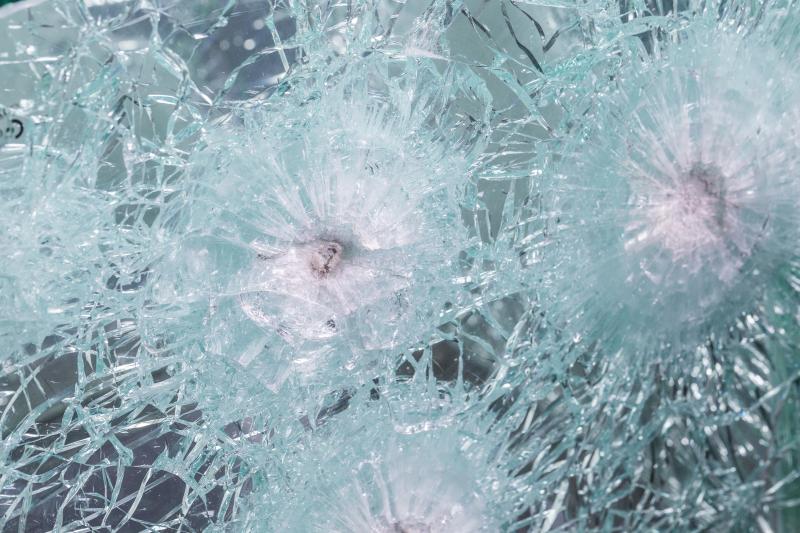Are Bulletproof Windows Shatterproof?

When discussing the safety and security of buildings, one of the first considerations is often the windows. Windows, after all, is one of the most vulnerable points in any structure. The concept of bulletproof glass has fascinated many, often portrayed in movies as an invincible barrier that can stop anything in its path. But is bulletproof glass truly shatterproof? As experts in window films and security solutions at Metro Tint, we aim to clarify this question by exploring the science and application of bulletproof windows.
Understanding Bulletproof Glass
At its core, what we commonly call “bulletproof glass” is more accurately termed bullet-resistant glass. This distinction is crucial because it sets realistic expectations about the performance of such materials. Bullet-resistant glass is engineered to resist the penetration of bullets through a combination of materials that absorb and disperse the projectile’s energy. However, the idea that it is completely impervious to bullets or that it will never break is a misconception. Bulletproof glass is designed to protect against specific threats, but its effectiveness depends on various factors, including the type of glass used, the thickness, and the specific kind of projectile it’s meant to stop.
The Science Behind Bulletproof Glass
We need to delve into how it’s constructed to understand why bulletproof glass isn’t shatterproof. Bullet-resistant glass is typically made from layers of glass and polycarbonate. The glass provides the hardness needed to resist penetration, while the polycarbonate adds toughness and flexibility, helping to absorb and distribute the bullet’s energy. This combination allows the glass to crack and absorb the impact, but it prevents the bullet from fully penetrating the material.
For instance, when a bullet strikes this type of glass, the outer layer may shatter, but the underlying polycarbonate catches the bullet and prevents it from passing through. This is crucial for preventing harm to people behind the glass. However, the fact that the glass shatters means it is not shatterproof in the traditional sense. Rather, it is designed to “fail safely” by holding together and maintaining a barrier even after cracking.
What Makes a Window Bulletproof?
“Bulletproof” can be misleading because no material is entirely bulletproof under all conditions. At Metro Tint, TX, we provide bullet-resistant glass to withstand specific bullets from certain firearms. The effectiveness of bullet-resistant glass depends on the combination of materials, often laminated glass layers and polycarbonate, to create a composite that can stop or slow down a bullet.
The glass layers are bonded with a strong adhesive, creating a laminated glass structure that can absorb and redistribute the force of the impact over a larger area. This structure is essential for stopping bullets, as it prevents the bullet from creating a localized point of failure. The thicker and more numerous these layers, the higher the level of bullet resistance.
Are Bulletproof Windows Truly Bulletproof?
In short, bulletproof windows are not “completely bulletproof.” They are designed to resist certain types of bullets, and the number of shots they can withstand varies depending on the glass’s construction. For example, glass that can stop a single shot from a high-powered rifle may not withstand multiple shots in the same area. This is why the industry often refers to such glass as bullet-resistant rather than bulletproof.
Furthermore, different grades of bullet-resistant glass are tested against various types of ammunition. Lower levels of protection might stop small-caliber handgun bullets, while higher levels are required to stop rounds from rifles. The glass is tested under controlled conditions to ensure that it meets the standards for the level of protection it claims to offer.
Bullet Resistance vs. Shatterproof Qualities
The distinction between bullet resistance and shatterproof qualities is important. Bullet-resistant glass is designed to prevent a bullet from penetrating through it, but it will often crack upon impact. These cracks are part of the glass’s job—absorbing the energy and preventing the projectile from passing through. Shatterproof glass, however, is designed to resist breaking into sharp pieces upon impact, but this does not necessarily mean it can stop a bullet.
Shatterproof glass, such as tempered glass, is often used when safety is a concern, but it does not provide the ballistic protection that bullet-resistant glass offers. Shatterproof glass is not intended to stop bullets; it simply breaks into smaller, less dangerous pieces rather than sharp shards. Therefore, while bullet-resistant glass has shatter-resistant properties, especially when it incorporates laminated layers, it is not shatterproof in the way tempered glass is.
The Role of Laminated Glass in Bullet Resistance
Laminated window or door glass is a critical component in bullet-resistant windows. This type of glass is created by bonding two or more layers of glass with interlayers of polyvinyl butyral (PVB) or ethylene-vinyl acetate (EVA). When a bullet strikes this laminated glass, the outer glass layer may break, but the interlayer holds the pieces together, preventing them from flying apart and causing injury.
This interlayer also plays a crucial role in absorbing and redistributing the bullet’s energy, which is key to stopping it from penetrating further. The strength and effectiveness of laminated glass in stopping bullets depend on the number of layers, the thickness of the glass, and the type of interlayer used. At Metro Tint, we offer custom solutions tailored to our clients specific security needs, ensuring that the laminated glass used in their bullet-resistant windows meets the required standards for their particular situation.
Types of Bullet-Resistant Windows
Not all bullet-resistant windows are created equal. Different types of bullet—or shatter-resistant glass are available, each designed to meet specific levels of threat. At Metro Tint, we offer a range of bullet-resistant glazing options, including glass-clad polycarbonate, laminated glass, and ballistic glass.
Glass-Clad Polycarbonate: This material is lighter and thinner than traditional bullet-resistant glass, making it suitable for situations where weight is a concern. It combines layers of glass with polycarbonate, offering high levels of protection while maintaining a clear, transparent appearance.
Laminated Glass: As mentioned earlier, laminated glass involves bonding layers of glass with plastic interlayers. This type of glass is highly effective at stopping bullets and is often used in high-security environments.
Ballistic Glass is a more general term for any type of glass designed to stop bullets. Depending on the level of protection needed, ballistic glass can vary in thickness and composition.
These options are available in different thicknesses and can be tailored to meet the specific needs of different applications, whether for protecting an office building, a retail location, or a residential property.
Installation and Integration with Existing Glass
A common question is whether bulletproof glass can be integrated into existing door and window frames. The straightforward answer is yes, but this process demands careful assessment of both the structural integrity of the building and the current glass in place.
Retrofitting existing window glass with bullet-resistant solutions typically involves applying a ballistic window film to enhance the current or fully replacing the traditional glass with a new, bulletproof glass unit. This approach ensures that the glass laminate integrates seamlessly with the building’s architecture, providing robust security without detracting from the property’s aesthetic appeal. Whether you’re looking to install bulletproof glass in doors, windows, or other vulnerable areas, our team at Metro Tint Texas is equipped to deliver solutions that enhance security and maintain your space’s visual integrity. Our expertise in installing bulletproof glass works ensures a smooth and effective transition from traditional glass to high-security glazing.
The Investment in Safety
Investing in bulletproof windows goes beyond property protection—it’s about ensuring the safety of those within. While not entirely shatterproof, ballistic glass provides an essential barrier that absorbs and disperses the energy from bullets, significantly reducing the risk of penetration and harm. At Metro Tint, we specialize in delivering high-quality ballistic glass solutions tailored to the unique security needs of our clients, whether for commercial buildings, retail spaces, or private residences.
Choosing Metro Tint means partnering with experts committed to your safety. Our ballistic glass products are rigorously tested to meet the highest standards, offering peace of mind and robust protection against potential threats. We’re here to guide you through every step, from selecting the right glass to ensuring a seamless installation. Your security is our priority, and we are dedicated to providing the best solutions to protect you and your property.


